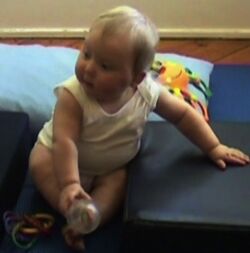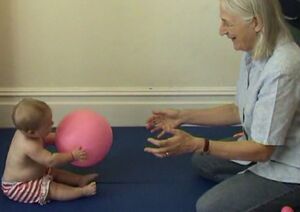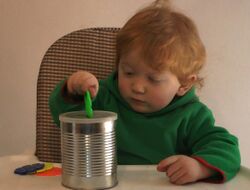Hand Function 7-24 Month Period
Top Contributors - Robin Tacchetti, Jess Bell, Tarina van der Stockt, Kim Jackson, Ewa Jaraczewska and Jorge Rodríguez Palomino
Introduction[edit | edit source]
Infants transitioning to toddlerhood start using their hands in more complex ways. In early infancy, hand use is subjected to random spontaneous movements of the arms. But as they age, infants engage in intentional movement patterns to reach for and grasp objects that they seek.[1] Successful reaching requires an infant to locate the target while opening and aligning the hand in preparation to grasp the object. Developmentally, reaching precedes grasping.[2] Between 9 and 19 months old, infants can plan ahead before reaching a target.[3] During this period, reaching and grasping are not limited to visual targets as infants can reach for auditory targets as well.[2] Throughout the 7 to 24 month period, infants will use their hands in a variety of ways. They also use different finger grasps to learn about, manipulate, and play with objects.[1]
Development of Hand Function[edit | edit source]
There are two important ideas to keep in mind when considering the development of hand function: cascades in development and perception-action loops with embedded exploration and selection.[1]
- Cascades in development:
- Development can be viewed as a cascade, with new behaviours building on established ones
- Thus, new skills are a combination of established development and new skill acquisition
- Perception-action loops with embedded exploration and selection:
- Infants will use repeated trials to learn new skills
- With each opportunity, they learn how to vary their movement to attain success
- The infant receives different sensory feedback as a consequence of their movement[1]
Perception[edit | edit source]
"Perception is the process by which we gather information about the physical structure of, and events in, the environment. Perception makes sense of the continuous flow of sensory information received by the brain by recognising patterns within the flow of sensory signals."[1]
It is an active process where the brain recognises patterns from the steady flow of sensory information. Examples of the perception of sensory information include tasting, feeling, looking and listening. For infants, hand use provides opportunities to learn about the properties of objects through touch.[1]
7 to 12 Month Period[edit | edit source]
Hands serve several purposes during the 7 to 12 month period:[1]
- They are part of the postural and locomotor systems
- Infants learn to: balance in sitting; crawl; buttock shuffle; cruise
- They are used for communication and in social interactions
- They are used to pick up, move and manipulate objects (i.e. to explore an object's different properties and find out what can be done with them)[1]
Hand-Object Actions[edit | edit source]
During the 7 to 12 month time period, infants will use their hands to interact with objects using various complex actions. Hand-object behaviours include:[1]
- Shaking
- Banging
- Patting, poking, stroking, flapping with the fingers
- Turning objects over
- Passing objects from one hand to the other
- Throwing and dropping objects
- Picking up, moving and dropping small and large objects
** By 12 months, an infant's reach and grasp motions are similar to that of an adult[4]
Grasp Patterns[edit | edit source]
When infants learn to sit independently, they become more efficient at reaching and grasping as their arms are no longer needed for support. Their grasp transitions from a reflexive palmar grasp to a radial palmar grasp to a pincer grasp. These fine motor adaptations facilitate more detailed manipulation of, and play with, objects. Using new grasps, infants begin releasing objects awkwardly at around 7 to 8 months. This becomes more purposeful as they age. By around 12 months, infants use fingering and hand-to-hand manipulations to investigate objects.[5] Repetitive trials allow them to find a finger pattern that is best suited to the size and shape of different objects.
Grasp patterns commonly seen during this period include:[1][6]
- Hook grasp: used to grasp small objects; fingers flexed at all joints
- Power grasp: used to hold a cylindrical object between fingers and thumb
- Palmar grasp: used to hold objects or tools with a long handle
- Circular grasp: used to grasp a ball or flat round object
- Chuck grasp: using the thumb, forefinger and ring finger; complex grasp typically only mastered when children are aged 4 or 5 years old
- Key grasp: used to grasp small flat surface between thumb and side of forefinger, other fingers flexed to provide support
- Pincer grasp: a precision grip - infants from around 8 to 10 months of age start to pick up small objects between the tip of their thumb and forefinger
Small Objects[edit | edit source]
At around 10 to 11 months old, infants begin to poke and pick up small objects. Poking involves using an extended forefinger while picking involves bending and extending the fingers using a raking action. As time progresses, infants will transition to a pincer or key grip to pick up small objects.[1]
Ball Activities[edit | edit source]
Ball play in infancy creates a variety of experiences to help infants learn how balls function. Infants learn to visually track moving balls as well as predict where the ball will stop moving. Anticipating the future location of a moving ball is an important skill for learning to catch a ball. Ball play with a partner allows infants to observe their partner's actions, discover different ways balls move, and how to catch and throw.[1]
Social Interaction and Communication Gestures[edit | edit source]
During the 7 to 12 month period, infants use their hands for social interaction and communication. Some of the gestures you might see during this stage are listed below:
- Waving
- Arm pointing
- Clapping hands
- Raising hands for hooray
- High five
- Copying actions[1]
12-24 Months[edit | edit source]
Task Structure[edit | edit source]
During the 12 to 24 month stage, toddlers use their hands for more goal-directed actions.[1] Their improved visual perceptual and spatial relation skills contribute to their improved ability to manipulate objects and use both hands at once.[5] Goal-oriented tasks require an understanding of the series of actions needed to complete the task (this is otherwise known as task structure). The three main components needed to complete a task structure are listed below:[1]
- Visual information gathered for planning movements
- Predict and adapt posture in response to limb movements
- Complete a sequence of movements
Toddlers learn to perform tasks with greater accuracy over time and through repeated experiences. During play activities, toddlers will adapt their grip, their body position and the pulling force applied through their arms to accommodate for the specific task. They quickly learn how to plan, execute and adapt their movements to attain their goal.[1]
Posting Activities[edit | edit source]
Posting or inserting activities begin when infants are aged between 12 and 24 months. This task requires the toddler to place objects through small openings such as small balls, rods or flat discs inserted into holes in the lids of a container. Through this undertaking, toddlers learn about sizes and shapes of objects as they fit through the various holes.[1]
Duration of Play[edit | edit source]
Toddlers aged between 12 and 24 months have brief sustained periods of focused attention on a task before moving onto another activity. These quick bursts of focused play are not a sign of a poor attention span, but rather they are an indication of toddlers employing their time in the most effective way to learn about the properties and affordances of many objects. "Affordance is defined as what the environment offers the individual and what it provides or furnishes."[7] A study by Herzberg et al.[8] showed that toddlers' object interactions were on average 9.8 seconds with transitions among dozens of toys and non-toys.
Video Resources[edit | edit source]
Resources[edit | edit source]
References[edit | edit source]
- ↑ 1.00 1.01 1.02 1.03 1.04 1.05 1.06 1.07 1.08 1.09 1.10 1.11 1.12 1.13 1.14 1.15 1.16 Versfeld, P. Hand Function 7-24 Months Course. Physioplus. 2022
- ↑ 2.0 2.1 Chinn LK, Noonan CF, Hoffmann M, Lockman JJ. Development of infant reaching strategies to tactile targets on the face. Frontiers in psychology. 2019:9.
- ↑ Kaur M, Detherage A, Needham AW. Unconventional tool use in infants: Using a familiar tool in a novel way in the second year of life. Cognitive Development. 2020 Apr 1;54:100881.
- ↑ Sacrey LA, Zwaigenbaum L, Bryson S, Brian J, Smith IM. The reach-to-grasp movement in infants later diagnosed with autism spectrum disorder: a high-risk sibling cohort study. Journal of neurodevelopmental disorders. 2018 Dec;10(1):1-1.
- ↑ 5.0 5.1 Gee BM, Engle J, Parker C, Stanger M, Call H, Peterson TW. Frequency and duration of developmental fine motor patterns in infants and toddlers: a pilot cohort study. Annals of International Occupational Therapy. 2020 Jan 1;3(1):21-8.
- ↑ Skills for Action. Accessible at: https://skillsforaction.com/different-ways-we-use-our-hands-everyday-function
- ↑ Sando OJ, Sandseter EBH. Affordances for physical activity and well-being in the ECEC outdoor environment. J. Environ. Psychol. 2020;69:101430.
- ↑ Herzberg O, Fletcher KK, Schatz JL, Adolph KE, Tamis‐LeMonda CS. Infant exuberant object play at home: Immense amounts of time‐distributed, variable practice. Child development. 2022 Jan;93(1):150-64.









